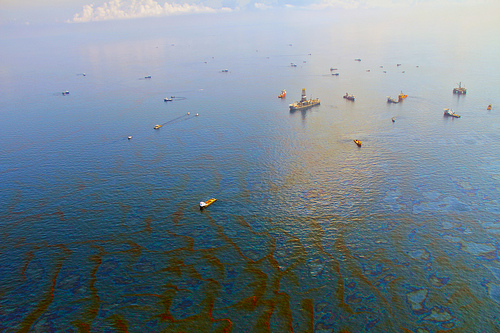Comparative Analysis Shows Petroleum Reduced Species Diversity
The Science
Researchers used metatranscriptomic analyses to compare the microbial populations in the Gulf of Mexico before and after the Deepwater Horizon oil spill to learn more about the impact of adding petroleum to the waters.
The Impact
Though the oil spill reduced the diversity of the microbial communities in the Gulf of Mexico, some microbial populations remain unchanged. The findings suggest that the original microbial community might be restored.
Summary

Comparing the expressed genetic information from microbial communities before and after the
2010 Deepwater Horizon spill indicated that while the overall population diversity has changed,
some microbes were unaffected. Creative Commons Attribution 2.0 Generic License by Green Fire Productions
One of the first studies published in the aftermath of the Deepwater Horizon oil spill involved DOE Joint Genome Institute researchers and confirmed that microbial communities did play a role in dispersing the hydrocarbons from the waters. A second study released in 2012 tracked the populations of several microbial species in the Gulf of Mexico as they dominated in the waters at various time points to remove different fractions of the oil.
In the study published ahead online August 1, 2013 in The ISME Journal, the researchers once again reviewed the microbial populations in the Gulf of Mexico, this time focusing on the expressed genetic information of an ecosystem or metatranscriptomes for those species in the bathypelagic zone, some 1,000 meters to 4,000 meters underwater where no sunlight penetrates. Their analysis of roughly 66 million transcripts sequenced for the study attributed just under half (40 percent) of the reads to just six Gammaproteobacteria genomes that are known to be capable of breaking down methane and petroleum.
The findings confirmed that the diversity of microbes and their functional roles in the waters has decreased since the oil spill. However, the team also found that some microbial populations did not appear to be affected by the events that took place three years ago, as their numbers remain similar both before and after 2010. “Despite the enormous bloom of hydrocarbon-degrading Gammaproteobacteria that increased bacterial cell counts by two orders of magnitude, members of the natural microbial community persisted at their pre-bloom activity levels and may be important in the re-establishment of the original microbial community,” the researchers concluded.
Contact
Mary Ann Moran
University of Georgia
mmoran@uga.edu
Funding
DOE Office of Science, Office of Biological and Environmental Research
Gordon and Betty Moore Foundation
U.S. National Science Foundation
Publication
Rivers AR et al. Transcriptional response of bathypelagic marine bacterioplankton to the Deepwater Horizon oil spill. ISME J. 2013 Aug 1. doi: 10.1038/ismej.2013.129.
Related Links
http://www.nature.com/ismej/journal/vaop/ncurrent/full/ismej2013129a.html#abs